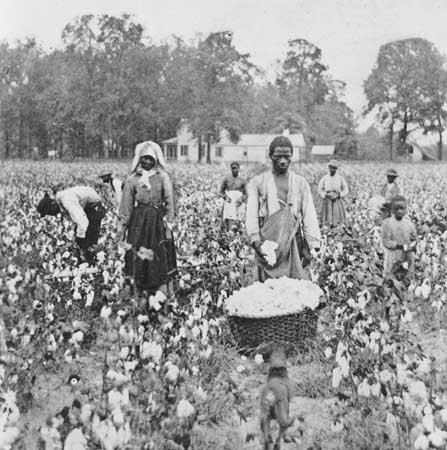The Southern Economy After Slavery
It’s time to begin preparing for our weekly Seminar.
Last time, we talked about the role of the Federal government, banking, and debt. The Federal Government faced its greatest test during the Civil War, and the Union survived, but racism economic pressures continued to curtail civil liberties for newly-freed African Americans in the South.
| 📜 Jim Crow: Black Codes | 📜 Henry Adams & Education | 📜 Sharecropping Contract (w/SK) |
|---|---|---|
|
|
|
|
After you have finished listing all of your groups questions, go through and rewrite any closed questions as openquestions.
By the year 1869 the Civil War had ended and Reconstruction was underway. Those enslaved were free under the Thirteenth Amendment, yet recovery for the South continued to be slow and harsh. It became clear that Congress would not be granting land to poor freedmen, and the concept of “40 acres and a mule” became a distant memory. Free Blacks, as well as poor Whites, had to find a way to make a living in a Southern region devastated for years to come by the after affects of war.
Many people were left without money or land; however, they did have the skills to be able to grow crops. Likewise, landowners often had plenty of land but little money for wages. Thus, many turned to a system of farming called tenant farming and sharecropping.
Tenant farmers usually paid the landowner rent for farmland and a house. They owned the crops they planted and made their own decisions about them. After harvesting the crop, the tenant sold it and received income from it. From that income, he paid the landowner the amount of rent owed.
Sharecroppers seldom owned anything. Instead, they borrowed practically everything — not only the land and a house but also supplies, draft animals, tools, equipment, and seeds. The sharecropper contributed his, and his family’s, labor. Sharecroppers had no control over which crops were planted or how they were sold. After harvesting the crop, the landowner sold it and applied its income toward settling the sharecropper’s account.
Most tenant farmers and sharecroppers bought everything they needed on credit from local merchants, hoping to make enough money at harvest time to pay their debts.
Many sharecroppers were freed slaves, working the same land that they had once been enslaved upon. Sharecroppers were also often uneducated and could not read or write, thus landowners could easily take advantage of the situation. Landowners were in charge of selling the crops and keeping records of any debt the sharecropper owed them. While sharecroppers always held hope that the yield of crops would be large, and that their debt (often for items like seeds and tools) had been paid to the landowner, sharecroppers often ended up empty handed. The landowner need only tweak the numbers a bit, and a sharecropper would remain indebted to the landowner year after year.
If the sharecropper tried to leave, he could be jailed for running out on such debt, legitimate or not. The legal system was likely to take the word of a rich, white landowner over a poor person and/or freed slave. The sharecropper system could thus be very profitable for a landowner, but a never-ending, unfair cycle for a sharecropper and his family. Landowners could also order sharecroppers to leave their land at any point for any reason. Such would often occur if a sharecropper became ill or injured.
The Industrial Revolution and the First World War brought temporary prosperity to both agriculture and forestry in North Carolina. Agriculture expanded to meet the increased demand for food and fertilizers were becoming available. However, sharecroppers saw little of this brief time period of prosperity, since the twenties and thirties brought the Great Depression. The boom years of the WWI were over and farm prices again dropped severely. Cotton sold for 35 cents per pound in 1919 but dropped to only 6 cents per pound in 1931. Total national farm income was 16.9 billion in 1919, and only 5.3 billion in 1932.